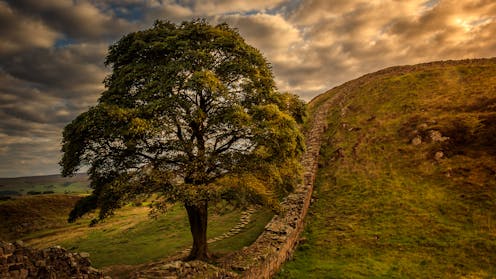Why the Sycamore Gap tree provoked such strong emotional reactions – a psychologist explains
Joe Rey Photography/Shutterstock
In September 2023, so many people were shocked when the famous Sycamore Gap tree, thriving in a dip along Hadrian’s Wall, was deliberately cut down overnight. For many, the tree symbolised British resilience, heritage and an enduring history. The public response was swift and intense, with widespread outrage and grief over the loss of this cultural landmark.
The two men convicted of felling the Sycamore Gap tree have been sentenced to four years and three months in prison. Meanwhile, the tree lives on thanks to an AI-generated alternate world in the film 28 Years Later.
As a psychologist, I’m interested in what inspired such a strong reaction to the destruction of a single tree. One psychological explanation, known as “terror management theory”, suggests that the emotional response reflects deeper anxieties about death – and not just about this tree.
Get your news from actual experts, straight to your inbox. Sign up to our daily newsletter to receive all The Conversation UK’s latest coverage of news and research, from politics and business to the arts and sciences.
Terror management theory, developed by psychologists Sheldon Solomon, Jeff Greenberg and Tom Pyszczynski, builds on the work of cultural anthropologist Ernest Becker, author of the Pulitzer prize-winning The Denial of Death (1973).
This book’s central idea is simple yet profound. In it, Becker proposes that our awareness of mortality creates the potential for considerable existential anxiety.
To manage this, we rely on cultural worldviews. These are our belief systems. These worldviews can be religious, secular, political or national. They all share a promise that life is meaningful and offer prescriptions for how we should live. When we live in accordance with our cultural values and standards – whether by being a good parent, a loyal citizen or following religious texts – we gain a sense of self-esteem and feel we are contributing to something enduring and significant.
These worldviews also offer the promise of immortality. Some do so literally, as in religious faiths that promise life beyond death. Others offer symbolic immortality, through lasting achievements, family bloodlines, or the continuation of one’s nation. By embedding ourselves in these worldviews, we gain a sense that some part of us will continue after we die.
Cultural symbols such as flags, religious icons, or even a tree can embody our core values and collective identity and are therefore treated with deep reverence. Throughout history, people have waged wars and shown intense emotional reactions to the desecration of such symbols (burning the American flag or the Qur’an, for example).
The Sycamore Gap tree was cut down in September 2023.
SunCity/Shutterstock
The Sycamore Gap tree carried similar significance. As a centuries-old landmark, it came to represent Britain’s heritage, strength and continuity. From the perspective of terror management theory, its felling may have stirred strong reactions because it reminded people that even the symbols we rely on for a sense of permanence can be suddenly lost.
This sense of cultural loss is also echoed by other recent events, such as Brexit and the immigration crisis. A collective fear over the erosion of British values and traditions place questions about the loss of British identity at the centre of public consciousness.
Rooted in mortality
Decades of psychological research support this theory’s claims. One common method (a technique called “mortality salience”) involves making participants subtly aware of their mortality (control participants are not reminded of death).
In studies carried out in the 1990s, researchers found that when the solution to a task required desecrating a cultural symbol, such as using an American flag to separate ink from a jar of sand, participants reminded of death took longer to complete the task and experienced greater apprehension.
Hundreds of studies also show how being reminded of death can increase anger and hostility towards people who threaten or violate one’s cultural values. One line of research examining reactions to those who commit moral transgressions may be particularly appropriate to this case.
For instance, in one study, participants reminded of their own death were more likely to support harsher punishments for those who committed moral transgressions such as someone who destroyed an irreplaceable artefact (much like the cutting down of a tree). Other research has shown similar effects: participants (including judges!) when reminded of death gave out harsher penalties or sentencing for those who have committed a crime.
You might question whether these effects truly reflect death anxiety or if they could be explained without invoking a desire for immortality. Research may provide compelling evidence. One study found that reminders of death increased support for harsher punishments for moral transgressors (replicating the study mentioned earlier).
However, when participants were first presented with evidence of an afterlife, the effect of death increasing harsher punishments disappeared. In other words, the promise that death is not the end appeared to buffer from the anxiety that death arouses.
The fall of the Sycamore Gap tree was more than a loss of natural beauty. It was, for many, a symbolic attack on permanence, on meaning, and on shared identity. Yet while such losses can stir outrage and calls for punishment, research also shows that when people endorse prosocial values like empathy, reminders of death can actually foster forgiveness towards those who commit moral transgressions.
According to terror management theory, these responses are not just about anger, but about what it means to be human in the face of inevitable death. In this light, the tree’s felling uprooted something sacred: a collective continuity that gives meaning to our brief lives. As we grieve its loss, perhaps we’re also mourning something more elusive – the comforting illusion that some things might last forever.
This article features references to books that have been included for editorial reasons, and may contain links to bookshop.org. If you click on one of the links and go on to buy something from bookshop.org The Conversation UK may earn a commission.
Don’t have time to read about climate change as much as you’d like?
Get a weekly roundup in your inbox instead. Every Wednesday, The Conversation’s environment editor writes Imagine, a short email that goes a little deeper into just one climate issue. Join the 45,000+ readers who’ve subscribed so far.
Samuel Fairlamb does not work for, consult, own shares in or receive funding from any company or organisation that would benefit from this article, and has disclosed no relevant affiliations beyond their academic appointment.


